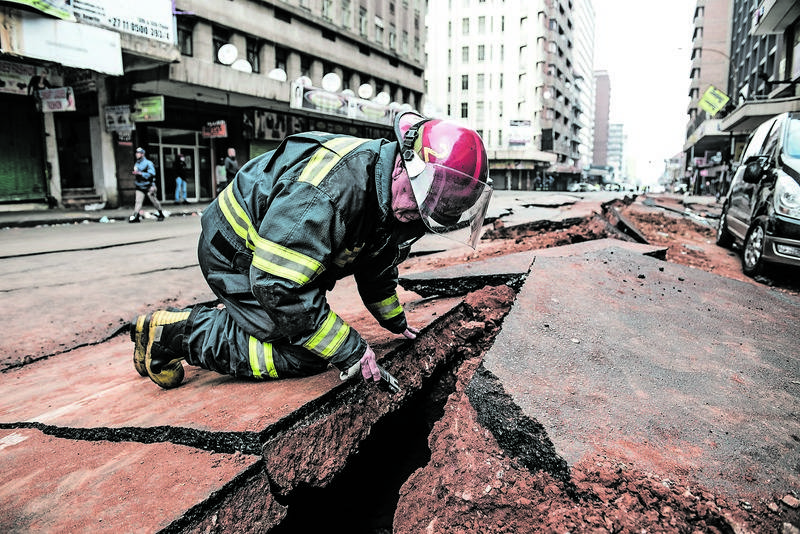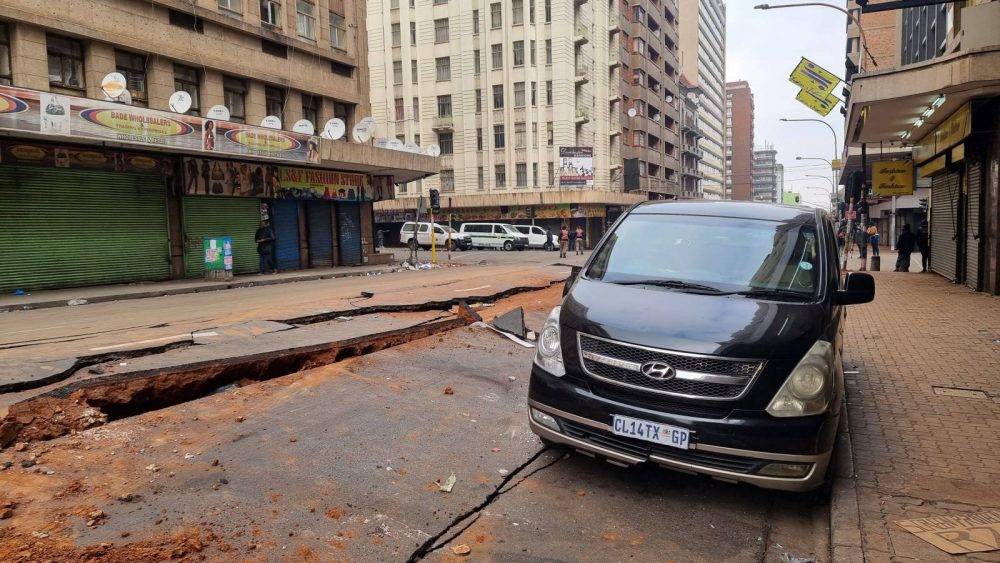The remnants of Bree Street on Thursday morning, following what is believed to have been a gas explosion. (Scott Peter Smith)
A preliminary investigation by the City of Johannesburg has identified three possible scenarios for the underground explosion that ripped through the city centre on Wednesday evening.
The first potential cause of the blast, which killed one person and injured about 50 others, is the ignition of methane gas in underground stormwater systems because of sewage entering it, city manager Floyd Brink, said at a briefing on Thursday night.
“The second possibility that we have considered is the ignition of natural gas mixed with air, which is oxygen in this case, in the underground stormwater drainage system of the service ducts.
“The third and last possibility that we have is the ignition of gas from a gas pipe burst.”
For now only one of these potential causes appears to be warranted, he said. “Accidental leakages of natural gas into the service duct reaching explosion concentration levels of between 5% to 15% and that was ignited by a source unknown at this stage.”
 Investigators are still determining the cause of the explosion. (Delwyn Verasamy/M&G)
Investigators are still determining the cause of the explosion. (Delwyn Verasamy/M&G)
Investigations would continue over the next few days to continue to try to locate the source of the explosion and its triggers.
The affected area spans Bree (Lilian Ngoyi) to Loveday streets on the western side of the city, to Claim Street on the eastern side, Rahima Moosa on the south side and Plein Street, on the north side of the city. A portion of Rissik Street was also destroyed.
Brink said the city had sent a team of civil engineers and structural engineers to inspected the structural integrity of buildings adjacent to the explosion.
“At this stage we can report … that there are no signs of failure that have been detected and the buildings are regarded at this point as structurally sound for occupation.
“We have also assessed the gas leaking into the atmosphere, because for us it then becomes quite important in terms of occupational health and safety, and we’ve been assured by the environmental services and the air quality controllers of the city that the gas leaking into the atmosphere poses no risk to residents as the concentration reduces rapidly in open air.”
But, if that gas had to leak into subsoil cavities such as basements, it can be fatal, he said.
On Friday, technical teams would use positive pressure ventilation fans on bulk services manholes to help disperse the underground gas. This equipment is safe “in the unlikely event of any spark”, Brink said.
“Some of these manholes [have] been welded specifically to prevent some form of theft as well as vandalism and that this stage we’re unable to immediately open those because we do fear that if we have to pry them open, those that have been welded, that in itself might ignite a further blast and further disaster in the area.”
He added that technical teams need to work with precision to avert further disaster.
 The remnants of Bree Street on Thursday morning, following what is believed to have been a gas explosion. (Scott Peter Smith)
The remnants of Bree Street on Thursday morning, following what is believed to have been a gas explosion. (Scott Peter Smith)
The city’s multidisciplinary team is working around the clock to secure the site, do investigations and restore services for residents in the area.
By 10pm on Thursday, Egoli Gas would have shut down its gas pipelines that run through the site of the explosion. Joburg Water had already isolated the water supply into the area and provided water tanks to support residents in the area. Mobile toilets would be dispatched to affected areas by Friday morning.
Brink said that once the site is declared safe, Joburg Water will require three days to repair the sewer lines in the area to activate services.
Emergency Management Services have a fire engine on standby at the site to monitor and be available to react to any incidents that might occur.
City Power’s technicians are assessing power lines for damage along the 400m blast radius and would only “re-energise the area once it has been declared safe to use”.
Brink said that 250 law enforcement officers and 50 private security officers are in the area. The tasks the city is undertaking are “complex” and, for now, no heavy equipment can be sent to the site. “The digging and trenching to be done now will have to be done by hand until we are confident that the site is safe and all hazardous factors are cleared.”